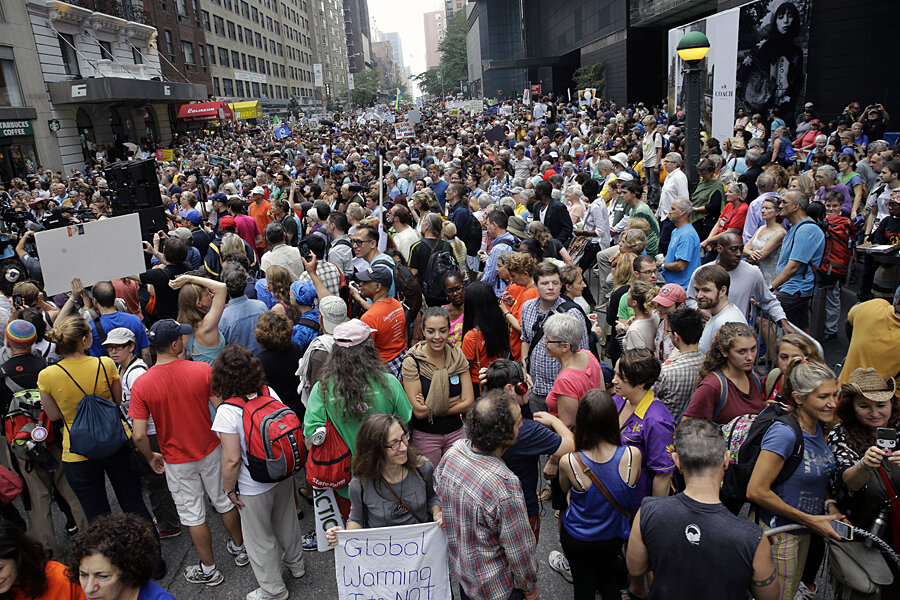People's Climate March urges climate change action
Loading...
| New York
Hundreds of thousands of demonstrators walked in the People's Climate March through Manhattan, warning that climate change is destroying the Earth — in stride with demonstrators around the world who urged policymakers to take quick action.
The Christian Science Monitor's Harry Bruinius was on the scene for the People's Climate March:
The parade began on the west side of Central Park and featured beating drums and dancers from indigenous peoples in Central and South American. They were followed by a cavalcade of union members, including hundreds under the blue United Auto Worker logo, many of whom carried the sign: “Climate change is real: Teach Science.” Thousands more community groups from around the world joined the march, each with identifying banners and political signs and slogans.
Most came on foot for the Sunday march, others with bicycles and walkers, and some even in wheelchairs. Many wore costumes and marched to drumbeats. One woman played the accordion.
But their message was not entertaining:
"We're going to lose our planet in the next generation if things continue this way," said Bert Garskof, 81, as a family member pushed his wheelchair through Times Square.
He had first heard about global warming in 1967, "when no one was paying much attention," said Garskof, a native New Yorker and professor of psychology at Connecticut's Quinnipiac University.
Organizers said more than 100,000 marched in New York, including actors Mark Ruffalo and Evangeline Lilly. They were joined in midtown Manhattan by United Nations Secretary-General Ban Ki-moon, former Vice President Al Gore and New York City Mayor Bill de Blasio.
On Tuesday, more than 120 world leaders will convene for the United Nations Climate Summit aimed at galvanizing political will for a new global climate treaty by the end of 2015.
"I am overwhelmed by such a strong power, energy and voice of people," Ban told reporters. "I hope this voice will be truly reflected to the leaders when they meet on September 23rd. Climate change is (a) defining issue of our time and there is no time to lose. If we do not take action now, we will have to pay much more.
De Blasio said, "My sense is the energy you see on the streets, the numbers that have amassed here and in other cities around the world, show that something bigger is going on, and this U.N. summit will be one of the ones where we look back and say it was a difference maker," de Blasio said.
The New York march was one of a series of events held around the world to raise awareness about climate change.
In London, organizers said 40,000 marchers participated, while a small gathering in Cairo featured a huge art piece representing wind and solar energy. In Rio de Janeiro, marchers with green hearts painted on their faces rallied at Ipanema Beach.
Celebrities in London including actress Emma Thompson and musician Peter Gabriel joined thousands of people crossing the capital's center, chanting: "What do we want? Clean energy. When do we want it? Now."
"This is important for every single person on the planet, which is why it has to be the greatest grassroots movement of all time," Thompson said. "This is the battle of our lives. We're fighting for our children."
In New York, a contingent came from Moore, Oklahoma, where a massive tornado killed 24 people last year, as did hundreds of people affected by Superstorm Sandy, which the U.S. National Oceanic and Atmospheric Administration and the British meteorological office said was made more likely by climate change.
In Australia, the largest rally was in Melbourne, where an estimated 10,000 people took to the streets with banners and placards calling on their government to do more to combat global warming.
Australian Prime Minister Tony Abbott was a particular target of the protesters in major Australian cities. Abbott's center-right coalition has removed a carbon tax and has restricted funding for climate change bodies since coming to power last year.
___
Associated Press writer Sylvia Hui in London contributed to this report.







